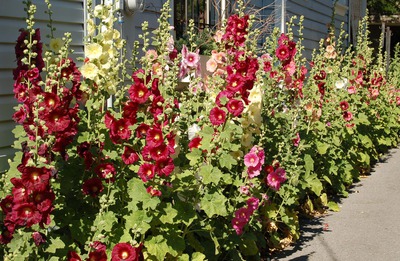 As this summer’s heat bakes people, pets, and plants alike, one source of distraction is the proliferation of large, colorful flowers that began blooming in early July. If you’re driving by in a car you might not notice them, but on foot or on a bike you can’t miss them.
As this summer’s heat bakes people, pets, and plants alike, one source of distraction is the proliferation of large, colorful flowers that began blooming in early July. If you’re driving by in a car you might not notice them, but on foot or on a bike you can’t miss them.
By Bill Lawyer
 As this summer’s heat bakes people, pets, and plants alike, one source of distraction is the proliferation of large, colorful flowers that began blooming in early July. If you’re driving by in a car you might not notice them, but on foot or on a bike you can’t miss them.
As this summer’s heat bakes people, pets, and plants alike, one source of distraction is the proliferation of large, colorful flowers that began blooming in early July. If you’re driving by in a car you might not notice them, but on foot or on a bike you can’t miss them.
That’s because the flowers are big, bold, and varied in color – sometimes several colors on the same plant.
We’re talking here about two kinds of plants, from different genera but the same family – the mallow family, malvaceae. And yes, this family includes the marsh mallows, whose roots’ gooey consistency (known as mucilage) when cooked inspired the invention of marshmallows.
While these two plants are different, many people don’t realize it because their flowers look very similar.
Now, if you have gone to the tropics, or a nearby botanical winter greenhouse, you’ve probably seen some of the many tropical species of the hibiscus genus of mallows. These can produce huge flowers – so big that they’re often used to teach people about the various parts and reproductive processes of all flowers – stamens, pistils, petals, etc.
Here in Rye, the most common cultivated members of the malvaceae family are hollyhocks and Rose of Sharons.
Hollyhocks, being biennial or short-lived perennial non-woody plants, are usually seen in flower beds along with other colorful perennials or annuals. They are in the Alcea genus, and they are native to southwest Asia or Eastern Europe. They can grow to a height of eight to ten feet.
 Rose of Sharon, on the other hand, are woody stemmed shrubs, growing up to 12 feet high if not trimmed back. They are in the hibiscus genus, but unlike the tropical varieties, they grow in temperate climates. Plant historians have determined that they probably originated in eastern Asia, even though their species name, syriacus, was assigned because Linnaeus, the famous 18th-century Swedish botanist, thought they came from Syria.
Rose of Sharon, on the other hand, are woody stemmed shrubs, growing up to 12 feet high if not trimmed back. They are in the hibiscus genus, but unlike the tropical varieties, they grow in temperate climates. Plant historians have determined that they probably originated in eastern Asia, even though their species name, syriacus, was assigned because Linnaeus, the famous 18th-century Swedish botanist, thought they came from Syria.
Interestingly enough (to this writer at least), each of Rye’s two cultivated mallows were adopted many centuries ago by Asian countries. The Rose of Sharon is the national flower of South Korea. The hollyhock flower, known in Japan as
Both hollyhocks and Rose of Sharon do very well in a wide range of soil and climate conditions. Both were brought to America by European settlers in the 18th century.
Hollyhocks die back every couple years or so, but they re-generate themselves with seeds. The seeds that are large (1/2 inch in diameter), flat, and coin-shaped seem to grow easily wherever they drop.
With some minimal care, Rose of Sharon will live indefinitely. While the plants thrive best in full sun, they can handle some shade. Deep shade can be hard on them, however.
They both do well in hot, dry weather conditions. When hydrangeas are wilting, they’re still going strong. When we have a damp, rainy summer, however, they might not even get around to flowering at all.
One final point of similarity – both of their English common names are derived from religious sources. Hollyhock comes from the Middle English term “holy mallow”. And when the King James version of the Bible was being translated in the 16th century from ancient texts, they thought that the biblical reference to Rose of Sharon
was the Hibuscus syriacus (scientists now have concluded it wasn’t).
No doubt people in medieval times believed that plants in the mallow family had healing powers. Even if that’s not the case, they do have the power to brighten our otherwise dog days of summer – right in our backyards.















